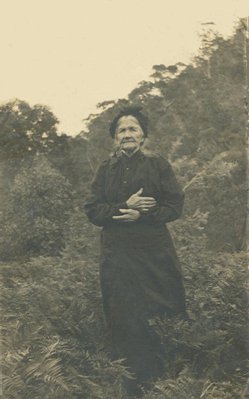As the ship moves away from the English shore, it begins to roll and pitch and the timbers groan - and once out of sight of land, a palpable fear grips the whole of the assisted passengers as a group. Exposed for over 30 hours to freezing wet weather on the deck of a steamer from Cork to Portsmouth, the girl who was to be my great-grandmother had already got a taste of things to come. But, she knew, with the Mother of God's merciful intervention, that she was going to survive the ordeal in front of her because she had survived the Great Famine when many were reduced to eating grass.
I have no written record of her voyage to Sydney. I do know that on her brother's ship some years later there were 44 crew plus 175 females, 172 males and 78 children emigrants. That's a lot of people on a ship of only 1119 tons. A craft that light would ride heaving waves like a corked bottle with those inside hanging on to some fixed object - all day - and then all night.
The sailing ships leaving Portsmouth were not designed for the mass emigrations that occurred from the early 1840s onwards. Continual crouching from a lack of headroom, fabric persistently damp from degraded caulking, leaks over bunks in heavy weather (bunks which might be shared by four people side-by-side like sardines), contaminated cask water, only four toilets for over 400 (who may have diarrhea at the same time), maddening itch from lice-infested bedding, lack of adequate light, lack of adequate ventilation and lack of adequate space for exercising.
Advertisement
Once the Cape of Good Hope was rounded, rough seas could last for many days - weeks even. In all that time passengers would be kept in the dim light below decks breathing air made fetid by unwashed bodies in unwashed clothes and a floor covered in vomit. As the weeks at sea dragged into months, there was the occasional nasty fight amongst the emigrants. Nevertheless, it would be the camaraderie of a suffering being shared which would have kept spirits from sinking into black holes.

Sydney! Poor girl. Greatly relieved to finally have arrived - but how bewildered she must have felt. How at the mercy of circumstances she must have felt. She was now on the opposite side of the planet to where the whitewashed stone cottage with the thatched roof and peat burning in the fireplace was sheltering the only people in the world she loved.
Mary McCaffery, the emigrant from the Old Country was now an immigrant to fill this colony's need for domestic servants and to add some balance to the excessive male population. She had to tolerate the demeaning work of servitude until she could find a man. When she found him, he took her to the diggings where she lived in a tent for the months it took him to realize that the backbreaking work was going to reward him with almost nothing. He had to find paying work.
The roads carved out of the bush were greatly winding and undulating and had a heavily broken surface. It took a horse and cart all day to travel 15 miles. For years the family travelled the countryside with the breadwinner picking up odd jobs, until in 1876 he received a grant of 137 acres on the rocky and forested slope of a 4577 foot high mountain where the winters were icy. This is where they built their home of split log walls, bark shingle roof and compacted dirt floor. Gradually, the house was made more comfortable and Mary was to live there for the rest of her life. That was 40 years - the last 13 of them alone as a widow.
Mary and the illiterate women of her class lived their lives without dental and medical treatment. The gynecological problems of which most women are afflicted by at least one, and which can be easily repaired today, had to be lived with. As each tooth rotted, it was pulled with pliers. And, Mary suffered the death of three of her six children. The person in the picture is that woman.
Advertisement
What we can all learn from Mary
Today's boat-people are illegals. Mary was not. Otherwise, like Mary, they are leaving most of their loved ones behind - maybe for good. Like Mary, they are resilient beyond the average Australian's comprehension. Like Mary, in their gratitude they would be willing to work hard to contribute to the country that gave them a second chance.
Is it right or wrong for a desperate person to attempt to become an uninvited resident in another country? Or, to put it the other way around, Is it right or wrong for us to attempt to keep such people out? I suspect that nobody knows the answers. But, I do know that speaking of boat-people as if they were vermin is very wrong. Our parliamentarians and much of the Australian population would not be so mean-spirited if they were to accept that the most admirable of all human attributes is not education or wealth or blue eyes - it is courage.
Discuss in our Forums
See what other readers are saying about this article!
Click here to read & post comments.
13 posts so far.